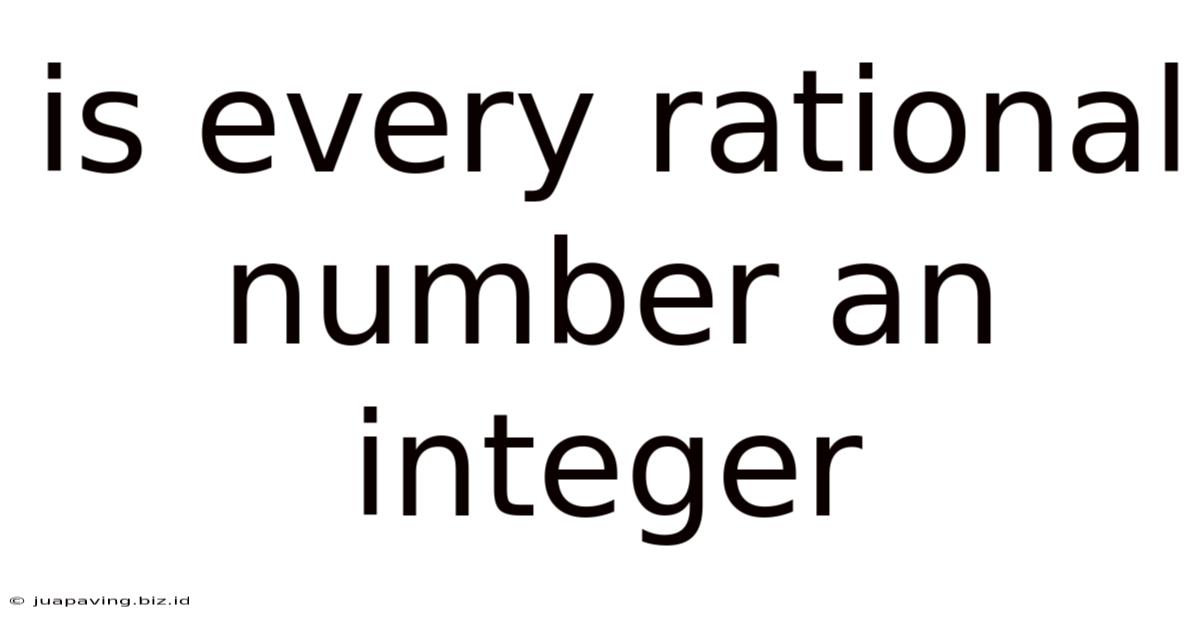Is Every Rational Number An Integer
Juapaving
May 10, 2025 · 4 min read

Table of Contents
Is Every Rational Number an Integer? Exploring the Relationship Between Rational and Integer Numbers
The question, "Is every rational number an integer?" is a fundamental one in mathematics, touching upon the core concepts of number systems. The answer, simply put, is no. While all integers are rational numbers, the reverse is not true. Understanding why requires delving into the precise definitions of rational and integer numbers and exploring the relationships between them. This article will delve deep into these concepts, providing clear explanations and examples to illustrate the distinctions.
Understanding Integers: The Foundation of Number Systems
Integers are the building blocks of many mathematical concepts. They represent whole numbers, both positive and negative, including zero. This set is often denoted by the symbol ℤ and can be represented as:
ℤ = {..., -3, -2, -1, 0, 1, 2, 3, ...}
Key characteristics of integers:
- Whole numbers: Integers lack fractional or decimal components.
- Closure under addition and subtraction: Adding or subtracting two integers always results in another integer.
- Ordered set: Integers can be arranged in a specific order, allowing for comparisons (greater than, less than, or equal to).
Rational Numbers: Expanding the Number System
Rational numbers significantly broaden the scope of numbers we can work with. A rational number is any number that can be expressed as a fraction p/q, where 'p' and 'q' are integers, and 'q' is not zero. The set of rational numbers is denoted by ℚ.
Key characteristics of rational numbers:
- Fractional representation: The defining characteristic is the ability to express the number as a fraction of two integers.
- Decimal representation: Rational numbers can be represented as either terminating decimals (e.g., 0.75) or repeating decimals (e.g., 0.333...).
- Density: Between any two rational numbers, there exists infinitely many other rational numbers.
- Closure under addition, subtraction, multiplication, and division (excluding division by zero): Performing these operations on two rational numbers always yields another rational number (provided you don't divide by zero).
The Crucial Distinction: Why Not Every Rational Number is an Integer
The key to understanding why every rational number isn't an integer lies in the definition itself. Integers are whole numbers; they lack fractional parts. Rational numbers, on the other hand, can have fractional parts. This is the fundamental difference.
Consider the following examples:
- 1/2: This is a rational number because it can be expressed as a fraction of two integers (1 and 2). However, it is not an integer because it represents a fraction, not a whole number.
- -3/4: This is another rational number, clearly not an integer.
- 7: This is both a rational number (it can be expressed as 7/1) and an integer. This highlights that all integers are also rational numbers, a crucial subset relationship.
Visualizing the Relationship: Venn Diagrams
A Venn diagram effectively illustrates the relationship between integers and rational numbers. Imagine two circles:
- Circle A: Represents the set of integers (ℤ).
- Circle B: Represents the set of rational numbers (ℚ).
Circle A is entirely contained within Circle B. This visually demonstrates that all integers are rational numbers, but not all rational numbers are integers. The area of Circle B that is outside Circle A represents rational numbers that are not integers.
Exploring Further: Irrational Numbers and the Real Number System
To complete the picture, we need to introduce irrational numbers. These are numbers that cannot be expressed as a fraction of two integers. Their decimal representations are neither terminating nor repeating. Famous examples include π (pi) and √2 (the square root of 2).
The union of rational and irrational numbers forms the set of real numbers (ℝ). The real number system encompasses all the numbers we typically encounter in mathematics. This can be visualized with an extended Venn diagram:
- Circle A: Integers (ℤ)
- Circle B: Rational Numbers (ℚ) encompassing Circle A
- Circle C: Irrational Numbers, separate from Circle B
The entire area encompassed by Circles B and C represents the real numbers (ℝ).
Practical Applications: Understanding the Implications
The distinction between integers and rational numbers has significant practical implications in various fields:
- Computer Science: Representing numbers in computer systems often involves considerations of integer and rational number data types. Integers are usually represented more efficiently, but rational numbers are necessary for calculations requiring fractions or decimals.
- Physics and Engineering: Many physical quantities are measured using rational numbers (e.g., 3.14 meters, 1/2 inch).
- Finance: Financial calculations extensively use rational numbers to deal with fractions of currency units (cents, fractions of shares).
Conclusion: A Clear Distinction, Essential Understanding
The question "Is every rational number an integer?" has a straightforward answer: No. While all integers are a subset of rational numbers, rational numbers encompass a far wider range of values, including those with fractional parts. This distinction is fundamental to understanding number systems and has significant practical implications across various fields. A firm grasp of the differences between integers and rational numbers is crucial for anyone working with numbers in a mathematical or computational context. Remember, integers are whole numbers, while rational numbers can be expressed as fractions of integers. The relationship is one of inclusion, not equivalence.
Latest Posts
Latest Posts
-
Controls The Activities Of The Cell
May 10, 2025
-
Prove The Alternate Exterior Angles Theorem
May 10, 2025
-
How Many Sets Of Chromosomes Are In A Diploid Cell
May 10, 2025
-
How Tall Is 62 Inches In Ft
May 10, 2025
-
The Smallest Contractile Unit Of Muscle Is A
May 10, 2025
Related Post
Thank you for visiting our website which covers about Is Every Rational Number An Integer . We hope the information provided has been useful to you. Feel free to contact us if you have any questions or need further assistance. See you next time and don't miss to bookmark.